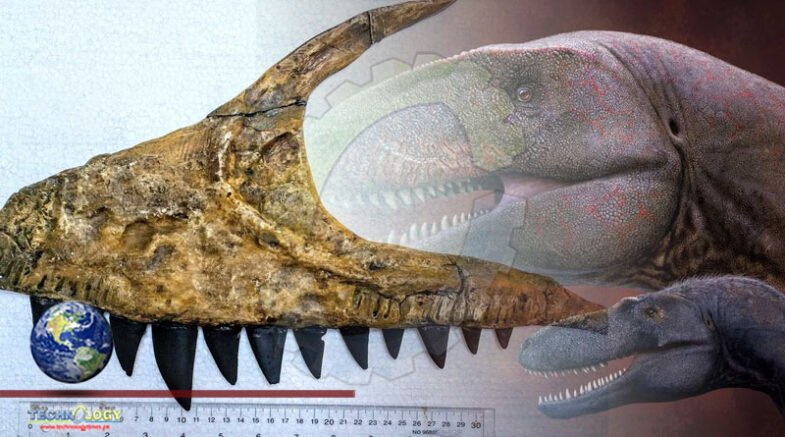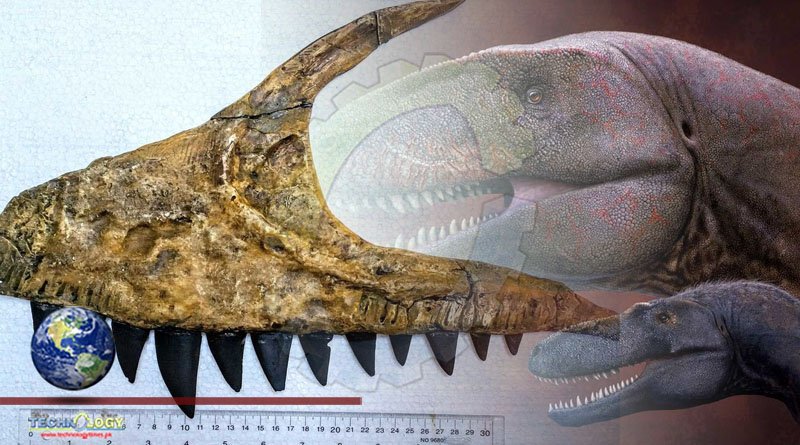A fossil jaw reveals the large predator lived 90 million years ago. Despite their fearsome reputation, tyrannosaurs were not always the largest or fiercest carnivores of the Mesozoic world.

Despite their fearsome reputation, tyrannosaurs were not always the largest or fiercest carnivores of the Mesozoic world. For tens of millions of years, the earlier relatives of Tyrannosaurus lived in the shadow of larger carnivores with serrated, knife-like teeth. These predators were the carcharodontosaurs, or “shark-toothed lizards,” and paleontologists have just named a new species from a pivotal point in dinosaurian history.
The new Fossil Jaw of dinosaur, represented by a bone found in the 90-million-year-old rock of Uzbekistan, is a carcharodontosaur estimated to be about 30 feet long. But that’s hardly all. This new dinosaur species also lived alongside a much smaller tyrannosaur and helps narrow down when the fearsome carcharodontosaurs began to cede the role of apex predator to bigger, badder tyrannosaurs.
Named Ulughbegsaurus uzbekistanensis, the new dinosaur is described today in Royal Society Open Science by University of Tsukba paleontologist Kohei Tanaka, University of Calgary paleontologist Darla Zelenitsky and colleagues. So far, the dinosaur is only known from a single bone—part of the upper jaw uncovered in the sandy reaches of the Kyzylkum Desert. Nevertheless, the anatomical details of the bone indicate that it belonged to the largest predator of its environment.
Ulughbegsaurus is not the first dinosaur to be found in the area. The fossil was preserved in what paleontologists known as the Bissekty Formation, a stack of 90- to 92-million-year-old rocks that preserves the remains of horned dinosaurs, duckbill dinosaurs, long-necked sauropod dinosaurs and more. “The Bissekty Formation represents one of the best-known ecosystems in Europe and Asia of its time,” Zelenitsky says. Among the most notable finds in the geologic section are the bones of Timurlengia, a tyrannosaur that grew to about ten feet in length. That’s roughly a third of the body length of Ulughbegsaurus Fossil Jaw.
“This is one new bone, and really just part of a bone, but its importance far eclipses its looks,” says University of Edinburgh paleontologist Stephen Brusatte, who was not involved in the new research. Not only is Ulughbegsaurus now the last-known carcharodontosaur, but the discovery also alters what paleontologists thought about life in the Bissekty Formation. “There may have been a complex interplay among Ulughbegsaurus and other, smaller predatory dinosaurs,” Zelenitsky says, with species of varying body sizes preferring different prey species. And this might have prevented tyrannosaurs from living large.
Small tyrannosaurs and large carcharodontosaurs have been found at other fossil sites before. In the 96-million-year-old rock of southeastern Utah, for example, paleontologists have found the bones of a large carcharodontosaur named Siats and a small tyrannosaur named Moros. But the new find, Zelenitsky and colleagues note, is the youngest occurrence of this carnivorous relationship that comes from a little-known time just before the rise of the tyrannosaurs.
Paleontologists don’t have an even understanding of the Age of Dinosaurs. Where fossils are found, how accessible they are to researchers, what sorts of questions paleontologists want to study and more all influence what time periods experts have come to know best. In terms of dinosaurian history, experts are struggling to understand the chunk of Cretaceous time between about 80 and 125 million years ago. That’s because that time period seems to have been one of significant change. In that window, carcharodontosaurs in the Northern Hemisphere went from apex predators to nonexistent, and in their absence tyrannosaurs began to get larger and larger Fossil Jaw.
Zelenitsky and colleagues tracked this trend by looking at the body sizes of both tyrannosaurs and the allosauroids, the group of large carnivorous dinosaurs that includes carcharodontosaurs. Around 160 million years ago, for example, the early tyrannosaur Guanlong from ancient China was overshadowed by the much larger Sinraptor. The same relationship is apparent in the Early Cretaceous, 125 million years ago, when the tyrannosaur Eotyrannus lived alongside the larger Neovenator in prehistoric England. The co-occurrence of Ulughbegsaurus and the little tyrannosaur Timurlengia fits this same pattern. “For many tens of millions of years, tyrannosaurs were the understudies of the allosauroids,” Brusatte says.
Only in environments where large, competing carnivores were absent did tyrannosaurs get big. Around 125 million years ago, for example, Early Cretaceous China was home to a large, 30-foot-long tyrannosaur called Yutyrannus. Paleontologists have not uncovered any big competing carnivore in the same rocks, fitting the trend that tyrannosaurs only flourished in the absence of competition. The trend is especially apparent after the 80-million-year-old mark. By this time, carcharodontosaurs could no longer be found in the Northern Hemisphere habitats they used to rule and huge tyrannosaurs like Dynamoterror and Gorgosaurus were evolving.
“I think that any finds we can make in or around the 90- to 80-million-year-old window can help shed light on this poorly-known interval of dinosaur-dominated ecosystems,” Zelenitsky says. Even though the relationship between tyrannosaurs, body size and competing carnivores now seems clear, paleontologists do not yet know why carcharodontosaurs vacated their role as the biggest predators of the Northern Hemisphere. It’s unlikely that tyrannosaurs simply clawed their way to the top. “Given that allosauroids were holding back tyrannosaurs for so many tens of millions of years,” Brusatte says, “I can’t envision that tyrannosaurs suddenly figured out how to out-compete the allosauroids.”
Something else must have happened, with changes to ancient environments—including a shift in the availability of prey species—being a favored hypothesis. “We don’t know why these dinosaurs lost their place as top predators, but perhaps it was linked to environmental changes that would have altered herbivorous dinosaur communities in or around this window of time,” Zelenitsky notes. More fossils will be needed to investigate further, to track how one group of impressive carnivores ceded the evolutionary stage to their bone-crushing successors.
Source Smithsonian Magazine
